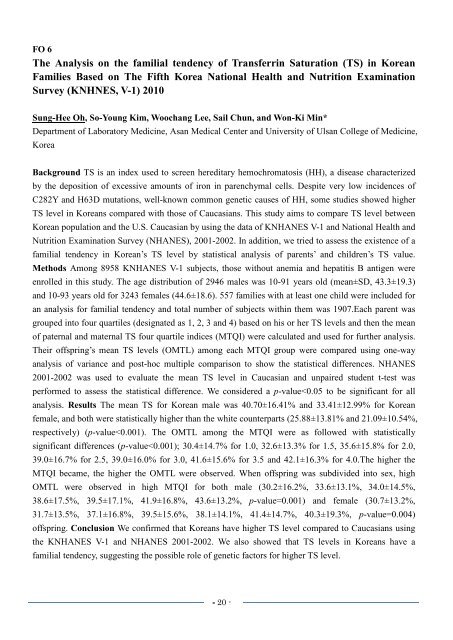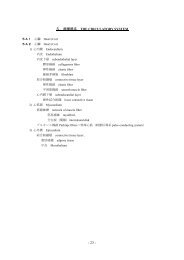Program / Abstract Book - KMU WWW3 Server for Education ...
Program / Abstract Book - KMU WWW3 Server for Education ...
Program / Abstract Book - KMU WWW3 Server for Education ...
Create successful ePaper yourself
Turn your PDF publications into a flip-book with our unique Google optimized e-Paper software.
FO 6<br />
The Analysis on the familial tendency of Transferrin Saturation (TS) in Korean<br />
Families Based on The Fifth Korea National Health and Nutrition Examination<br />
Survey (KNHNES, V-1) 2010<br />
Sung-Hee Oh, So-Young Kim, Woochang Lee, Sail Chun, and Won-Ki Min*<br />
Department of Laboratory Medicine, Asan Medical Center and University of Ulsan College of Medicine,<br />
Korea<br />
Background TS is an index used to screen hereditary hemochromatosis (HH), a disease characterized<br />
by the deposition of excessive amounts of iron in parenchymal cells. Despite very low incidences of<br />
C282Y and H63D mutations, well-known common genetic causes of HH, some studies showed higher<br />
TS level in Koreans compared with those of Caucasians. This study aims to compare TS level between<br />
Korean population and the U.S. Caucasian by using the data of KNHANES V-1 and National Health and<br />
Nutrition Examination Survey (NHANES), 2001-2002. In addition, we tried to assess the existence of a<br />
familial tendency in Korean’s TS level by statistical analysis of parents’ and children’s TS value.<br />
Methods Among 8958 KNHANES V-1 subjects, those without anemia and hepatitis B antigen were<br />
enrolled in this study. The age distribution of 2946 males was 10-91 years old (mean±SD, 43.3±19.3)<br />
and 10-93 years old <strong>for</strong> 3243 females (44.6±18.6). 557 families with at least one child were included <strong>for</strong><br />
an analysis <strong>for</strong> familial tendency and total number of subjects within them was 1907.Each parent was<br />
grouped into four quartiles (designated as 1, 2, 3 and 4) based on his or her TS levels and then the mean<br />
of paternal and maternal TS four quartile indices (MTQI) were calculated and used <strong>for</strong> further analysis.<br />
Their offspring’s mean TS levels (OMTL) among each MTQI group were compared using one-way<br />
analysis of variance and post-hoc multiple comparison to show the statistical differences. NHANES<br />
2001-2002 was used to evaluate the mean TS level in Caucasian and unpaired student t-test was<br />
per<strong>for</strong>med to assess the statistical difference. We considered a p-value



